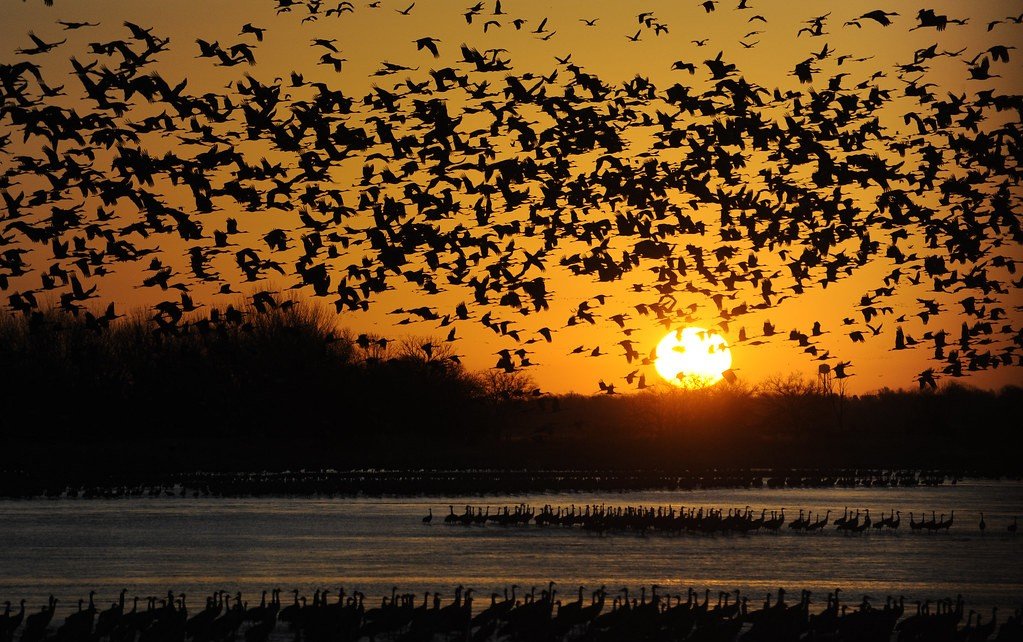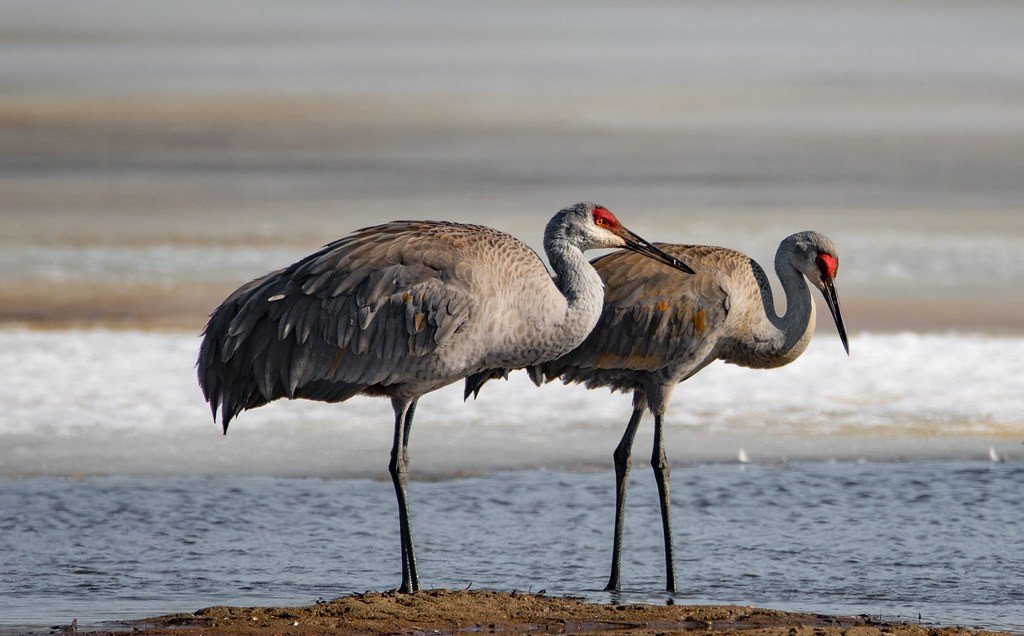Every March, the skies above Nebraska transform into something magical. Picture this: approximately 500,000 sandhill cranes descending upon the Platte River valley like gray clouds taking flight. The sight is so breathtaking that many visitors describe it as life-changing.
This ancient migration has been happening for thousands of years, yet it still captures hearts and minds from around the world. These magnificent birds turn central Nebraska into nature’s greatest theater, creating a spectacle that National Geographic has named one of North America’s most extraordinary wildlife events. So let’s dive into this remarkable phenomenon that every spring along the Platte River.
The Great Gathering

More than 80 percent of the world’s population of sandhill cranes converge on Nebraska’s Platte River valley, creating what experts call the largest crane gathering on Earth. The numbers are staggering when you really think about it. Every March, roughly 500,000 sandhill cranes land in Nebraska, turning the quiet river valley into a bustling avian metropolis.
What makes this gathering so unique is its concentration. By March, nearly 80% of the world’s population crowds a 150-mile stretch of the river, essentially funneling through what scientists describe as a bottleneck in their migration route. The scene is absolutely mind-boggling when you witness thousands upon thousands of these graceful birds filling the sky simultaneously.
Ancient Travelers on Modern Rivers

Fossil records place sandhill cranes in Nebraska more than nine million years ago, predating the Platte River, which formed approximately 600,000-700,000 years ago during the Pleistocene epoch. This means these incredible birds have been making this journey for far longer than the river they now depend on has even existed. Their ancient heritage places them among the oldest living bird species on our planet.
The landscape then was savanna-like, inhabited by rhinos, camels, and elephants now extinct. Today’s cranes are living links to this prehistoric world, having adapted to dramatic environmental changes over millions of years. Their resilience through such vast stretches of time makes their current journey even more remarkable.
Perfect Timing and Peak Season

They usually arrive in the central Platte River valley in February. Numbers peak about mid to late March. Large numbers remain through the first week of April, though the exact timing can shift based on weather patterns. The 2024 spring migration was particularly impressive, breaking records that had stood for years.
The 2024 spring migration was record-setting with 736,000 Sandhill cranes counted from Overton to Chapman. The previous record was 670,702 in 2019. Weather plays a huge role in their arrival patterns, with warm springs bringing earlier migrations while harsh winters can delay their northern journey by several days or even weeks.
The River’s Critical Role

The most important is the Platte River itself. The river is very shallow and sandbars dot the channels. It is here the cranes rest at night, gaining protection from predators like coyotes. The Platte’s unique characteristics make it irreplaceable for these magnificent birds.
Cranes generally prefer to roost in water depths less than 0.40 meters with velocities less than 0.70 meters per second. The river’s shallow, braided channels provide exactly these conditions across miles of habitat. This perfect match between bird needs and river characteristics explains why the cranes have chosen this specific location for their critical stopover.
Fueling Up for the Journey Ahead

An individual crane spends about 29 days along the Platte River. During that time, it will acquire up to a pound of fat, which provides the energy necessary to complete the migration and initiate nesting. About 90 percent of their diet consists of corn. This weight gain is absolutely essential for their survival during the thousands of miles still ahead.
The composite diet of cranes was 97% corn and 3% invertebrates, including 2% earthworms, 0.5% snails, and 0.5% insects. Presumably, corn provided energy, whereas invertebrates from grasslands and alfalfa fields provided supplemental nutrients to compensate for protein and calcium deficiencies in corn. The surrounding cornfields have become crucial to their survival strategy.
The Famous Crane Dance

Courting cranes are magnificent as they stretch their wings, pump their heads, bow, and leap into the air in a graceful and energetic dance. Parents will dance with their chicks for the entire first year of their lives. Juvenile Sandhill Cranes will use the complex dance steps they learned to select a mate when they are two to five years old. These dances are truly spectacular to witness.
All cranes “dance” with one another, bowing, jumping, running, wing flapping, and tossing sticks or grass. Though most commonly associated with courtship, cranes of all ages may dance in any season. Crane dancing is thought to strengthen the bond between pairs and may also reduce aggression between birds. The dance can spread rapidly through an entire flock, creating an unforgettable display of synchronized movement.
Sunrise and Sunset Spectacles

The morning liftoff either happens slowly, with smaller groups of cranes leaving as the sun continues to rise, or more frequently with tens of thousands of sandhill cranes leaving all at once in a cloud that blots out the sky. These morning departures create some of the most breathtaking wildlife viewing experiences in North America.
Groups of cranes pour into the river silhouetted by the setting sun as they dance and socialize before falling asleep. Evening returns to the river are equally mesmerizing, as waves of cranes fill the sky in preparation for their nightly roost. The sounds alone are enough to give you goosebumps.
Ecological Importance and Habitat Challenges

The central Platte River is important to sandhill cranes and other migratory birds because it serves as a key stopover site where birds rest and store energy to continue their northward migration and subsequently breed. Sandhill cranes that stop in Nebraska continue north, with breeding ranges across the northern United States, Canada, and Siberia. This makes the Platte River valley a critical link in a chain stretching across continents.
In Nebraska there used to be about 200 miles of river suitable for cranes whereas now they’re crowded into a 50-mile stretch between Grand Island and Kearney. Thanks to numerous dams, only about 30 percent of the Platte’s water makes it as far as the Rowe Sanctuary. Human development has dramatically reduced the available habitat, concentrating the birds into smaller areas.
Conservation Success and Ongoing Threats

Populations of migratory subspecies passing through Nebraska are stable and increasing. Lesser sandhill crane is the smaller subspecies and comprises approximately 80% of birds staging along the Platte River. This represents a remarkable conservation success story after populations hit dangerous lows in the 1960s.
Habitat loss due to development is the chief threat to Sandhill Cranes, especially in important staging areas such as Nebraska’s Platte River. Scientists estimate that approximately 80 percent of all migratory Sandhill Cranes in North America use a 75-mile stretch of Nebraska’s Platte River during spring migration. Climate change poses additional challenges, with rising temperatures potentially altering their migration timing and routes.
Nebraska’s sandhill crane migration stands as one of nature’s most incredible spectacles, a testament to the endurance of these ancient travelers. The sight of half a million cranes transforming the Nebraska sky into a living river of wings continues to inspire awe in everyone who witnesses it. Their journey reminds us that some natural wonders are worth protecting for future generations to experience.
What would you think if you saw half a million birds filling the sky above you? Tell us in the comments.

Hi, I’m Andrew, and I come from India. Experienced content specialist with a passion for writing. My forte includes health and wellness, Travel, Animals, and Nature. A nature nomad, I am obsessed with mountains and love high-altitude trekking. I have been on several Himalayan treks in India including the Everest Base Camp in Nepal, a profound experience.



